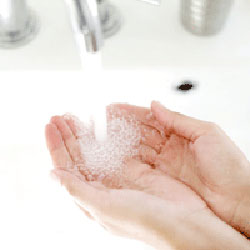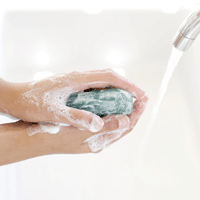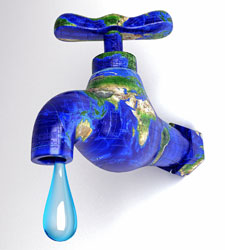Water Pollution and Conservation
 Overview
Overview

Water is a vital resource, yet access to fresh water is becoming scarcer both globally and domestically. It is estimated that by 2025, water hot spot areas in 17 western U.S. states could face intense conflicts over the water needed for urban growth, irrigation, recreation, and wildlife. In the Midwest, water conservation is receiving increasing attention from agencies, the public, the media, and businesses. For example, the MN Department of Natural Resources has designated there groundwater management areas “to address difficult groundwater-related resource challenges.” Even here in the land of 10,000 lakes, we must think about how we manage our water supplies to ensure that we can continue to depend on clean water.
Water Regulations in Healthcare Facilities
Minnesota businesses can access regulatory information about water and water quality by visiting the Minnesota Pollution Control Agency’s Water page. In general, hospitals in Minnesota require wastewater discharge permits, while smaller healthcare facilities typically do not require discharge permits. Information about these permits can be found on the Water Quality Permit Application page on the MPCA’s website. Areas of concern for healthcare wastewater discharge include suspended solids (TSS) and chemical oxygen demand (COD), which at high concentrations (above 200-500mg/l depending on the POTW) may result in additional charges for strength. Mercury is the next contaminant of concern and many hospital discharge permits require monitoring of mercury discharge concentrations. Other areas of concern are high or low pH and toxic metals (copper, chrome, lead, nickel, and cadmium). If your discharge from laboratories, cooling towers, or other areas contain these materials, talk to your sewer authority about whether any actions might be prudent or required. For general information about National Pollutant Discharge Elimination System (NPDES), and its links to the federal Clean Water Act, visit the Environmental Protection Agency’s NPDES page.
For the most complete information regarding the water rules for your facility, we recommend contacting your sewer authority, because these authorities set the rules for concentration and content of wastewater discharges. The Metropolitan Council of Environmental Services (MCES) is the appropriate contact for the seven-county metropolitan area. If your facility is located outside this area, contact your county office.
Water Pollution from Pharmaceuticals, Personal Care Products, and Chemicals
Water pollution is a major concern for healthcare facilities. Many bodies of water in Minnesota are classified as “impaired,” meaning that pharmaceuticals, chemicals, personal care products, fertilizers, mercury, PCBs, and more substances are ended up in our water and causes changes to aquatic ecosystems. The MPCA maintains a map of impaired waters across Minnesota; visit their webpage to learn more.

The safest and most environmentally responsible way for a patient or consumer to dispose of pharmaceutical waste is to use a county collection site. Most counties across the state offer this service, and we recommend researching the sites available in your county and creating a handout for patients who ask you to take back medications or otherwise inquire about disposal. A helpful starting place is the MPCA’s webpage on disposing of unwanted medications. Medication disposal programs are often called “Take it to the Box” and are usually run from a sheriff’s office or county building. No one entity offers a complete list of medication drop-off locations in Minnesota, but an internet search of “Take it to the box + [your county name]” should direct you to the programs available in your county.
Water Conservation Strategies for Healthcare

Practice Greenhealth has numerous case studies, best practice checklists, and statistics on water use in healthcare. They note that hospitals that have implemented reduction strategies have seen water use go down by an average of 20-30 percent. Their water conservation resources are free and can be found at on Practice Greenhealth’s Water webpage. When Every Drop Counts, a comprehensive water conservation checklist for hospitals and medical facilities developed by the North Carolina Division of Pollution Prevention and Environmental Assistance, is another good place to start.
MnTAP also maintains resources on water quality and conservation. Learn more by visiting the MnTAP Water page.